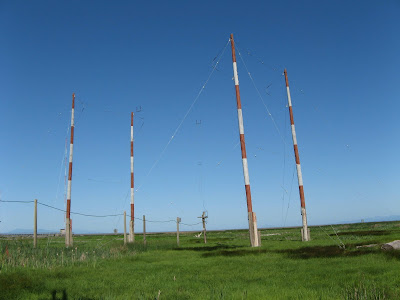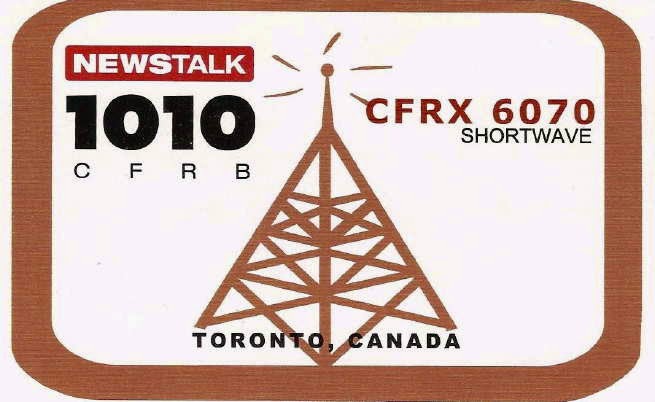Posts Tagged ‘shortwave’
 Historic adverts?
Historic adverts?
Thanks to Phil G4HFU (see earlier post) I have been reacquainted with the old PW adverts that got me dreaming over 50 years ago. I wonder if other blog readers can point me in the direction of old UK magazines and adverts? I was first interested in radio and SWLing in the early 1960s.
Back then, the world was a very different place. The Beatles were still in the future. We lived under the constant fear of all out nuclear war (I was terrified in the 1962 Cuba crisis) and most amateur DX was by CW or AM. Although RTTY was around, most digital modes were not. Magazines like Practical Wireless, Radio Constructor and Short Wave Magazine were filled with goodies I drooled over, but could not afford. Even now I do not like parting with money for amateur gear unless there is a good chance of getting very many years of good service from it.
 CKZU – 6160 Close-Up
CKZU – 6160 Close-Up
 |
| courtesy: googlemaps.ca |
On a weekend bike ride along the West Richmond dyke, Mark (VA7MM) snapped this wonderful close-up view of the system:
 | ||||
| courtesy: VA7MM |
So the next time you are tuning around 40m, drop down a bit and see how their signal sounds at your location ... you may be pleasantly surprised.
 49m Canadians QSL’d
49m Canadians QSL’d
An e- mail report to long-time veri-signer and Ontario DX Association mainstay, Harold Sellers, brought a quick e-mail verification. I was hoping that CFVP would still be issuing a paper QSL but nowadays that is getting to be a rarer and rarer policy.
Harold also reports the following details about CFVP:
 |
| CFVP Tower courtesy: Harold Sellers |
Steve reports that CFRX is simulcasting CFRB (1010kHz) using 1000 watts into an omnidirectional vertical antenna. They have received several reports from Europe over the many years that he has been sending verifications.
Now to tackle CKZU!
 A 49m Bandscan
A 49m Bandscan

As indicated in an earlier blog, a planned scan of the 49m band was made a few nights ago ... one at 0400Z (10PM local) and another at 1200Z (5AM local). Both had a decidedly different flavor. Frankly I was surprised at the number of broadcasters and especially the number from Asia, China mainly, heard in the morning scan. One information source I found indicates that most of the strong shortwave signals from China are more designed for jamming than for program content.
My initial impression was that many of the more interesting low power targets from Central / South America and Africa may be a thing of the past but I may be wrong. The 'news' page, of the World Wide DX Club, seems to indicate that there are still lots of juicy targets out there if you are willing to put in the time to look for them, as many seem interested in doing. There also seems to be a larger variety of DX targets available in the higher bands such as 25m and 31m.
For the most part, these broadcasters don't fool around with QRP, and their signals are pretty dominant. Conditions of late have not favored Europe or Africa so there may be more activity from these regions than I think.
The following stations were logged with the Perseus SDR along and the 10'x20' loop / Wellbrook preamp, looping E-W, at 0400Z:
5810 EWTN (inSpan) Vandiver, Alabama 500kw
5830 WTWW (rel) Lebanon, TN 100kw
5850 Sun Power Radio (RMI) Okeechobee, FL 100kw
5890 WWCR (rel) Nashville, TN 100kw
5910 NHK Radio Japan Issoudun, France 100kw
5920 WHRI (rel) s/off Cypress Creek, SC 250kw
5920 Radio Romania Galbeni 300kw
5935 WWCR (rel) Nashville, TN 100kw
5970 Radio Italia (in Portuguese) Belo Horizonte, Brazil 10kw
5980 Channel Africa s/off Meyerton, SA 250kw
5985 NHK World Radio Japan (in Span) Okeechobee, FL 100kw
6000 Radio Habana Cuba Titan Quivican 250kw
6020 Radio Gaucha s/off Porto Alegre, Brazil 10kw
6030 Radio Marti Greenville, NC 250kw
6040 Radio RB2 (in Portuguese) Curibata, PR 10kw
6050 unid / weak
6060 Radio Habana Cuba La Habana 100kw
6070 CFRX Toronto, ON 1kw
6090 Caribbean Beacon (rel) Anguilla 100kw
6125 Deutsche Welle s/off Manama, Bahrain 250kw
6160 CKZU Vancouver, BC 500w
6165 Radio Habana Cuba La Habana 100kw
6175 Voice of Vietnam Cypress Creek, SC 250kw
6180 Radio Nacional Brazilia Brasilia 250kw
6185 XEPPM Radio Educacion Mexico City 1kw
These stations were logged at 1200Z, using the same system:
5830 WTWW Tennessee 250kw
5875 BBC Nakhon Sawan (Thailand) 250kw
5915 China Radio Int'l Hohhot 100kw
5925 Voice of Vietnam 2 Hanoi 50kw
5935 PBS Xizang Lhasa-Baiding 100kw //6110
5955 China Radio Int'l Beijing 150kw
5970 PBS Gannan Hezuo 15kw
5975 CNR 8 Beijing 100kw
5985 Myanmar Radio Yangon 25kw
5990 unid China Radio Int'l same interval sig as 5915
5995 Taiwan Xing Xing Kuanyin sign-on 10kw
6000 CNR 1 Beijing 100kw
6003 VOH Korea (S) 100kw
6015 KBS Hanminjok Bangsung 1 Hwaseong (S. Korea) 100kw
6020 weak / poss Radio Victoria Lima with time pips 3kw
6030 CNR 1 Beijing 100kw
6040 weak w/eastern music/ poss Air Jeypore India 50kw
6050 weak / poss RTM Malaysia 10kw
6055 weak w/continuous music / unid
6060 Radio Argentina Exterior General Pacheco 100kw
6065 CNR 2 Beijing 150kw
6070 Voice of Korea / in Japanese Kanggye 10kw
6080 PBS Hulun Buir Hailar (Mongolia) 10kw
6090 NHK World Radio Japan Ibaragi-Koga-Yamata 300kw
6095 KBS World Radio Kimjae (S.Korea) 250kw
6100 Radio Serbia Bijeljina 250kw
6105 Radio Taiwan Int'l Kouhu 100kw
6110 Voice of America / chinese Udon Thani (Thailand) 250kw
6110 PBS Xizang Lhasa-Baiding 100kw //5935
6115 Voice of Strait Fuzhou (PRC) 50kw
6125 CNR 1 Beijing 100kw
6155 CNR 2 Beijing 150kw
6160 CKZU Vancouver 500w / relay CBU AM
6165 Voice of Vietnam 4 Hanoi 50kw
6175 CNR 1 Beijing 100kw
6180 CNR unid but time pips match other CNRs
6180 Radio Taiwan Woofferton 250kw
6195 BBC Kranji (Singapore) 125kw
6200 Voice of Jinling Manjing (Singapore) 100kw
6280.14 Unid with music / poss SOH Xi Wang Zhi Sheng Tanshui (Taiwan) 100 watts
6365 Hand sent keyer CW with callups 7CJ 7CB 7FB QTC into nr/ltr groups
6389 similar to above but nr/ltr groups
6400 Pyongyang Kanggye (N. Korea) 50kw
6501 USCG NMO Honolulu with wx bdcst
6518 Voice of the People Kyonggi-do-Koyang (S. Korea) 50kw
6518 N. Korean jammer Kujang 250kw
6600 Voice of the People Kyonggi-do-Koyang (S. Korea) 50kw
6600 N. Korean jammer Kujang 250kw
6679 Honolulu Radio w/ aviation Volmet
6754 Trenton Volmet wx bdcst
The number of broadcasters using remote sites is also surprising. It seems that the relaying of program content for others is big business and for many countries, much cheaper than running their own 250kw stations.
Some links that I have found very useful for identifying SW BC stations:
http://www.geocities.jp/binewsjp/ic/bia15.txt
http://www.short-wave.info/
http://www.shortwaveschedule.com/
 Persistent Cycle 24
Persistent Cycle 24
 |
| courtesy: http://sdo.gsfc.nasa.gov/ |
Our Sun's latest rotation is showing several new large sunspot groupings, all very capable of unleashing a new round of solar flares and associated disruption ... if nothing else, Cycle 24 is persistent!
 |
| courtesy: http://sdo.gsfc.nasa.gov/data/ |
 |
| courtesy: http://www.swpc.noaa.gov/ |
The software gurus at NOAA have been busy once again, this time revamping several of their visual models to an 'animated' mode. The Ovation Auroral map is particularly interesting when run in this mode as it shows the auroral field's activity visually over the past 24 hours. The display gives one a new appreciation for the dynamics of such large scale events:
 |
| courtesy: http://www.swpc.noaa.gov/communities/radio-communications |
 |
| courtesy: http://www.dxmaps.com/ |
 The Lonely 49 Meter Canadians
The Lonely 49 Meter Canadians
Apparently there is still activity coming from CKZU (6160KHz), CKZN (also on 6160KHz), CFVP (6030KHz) and CFRX (6070KHz). These are all low-powered (100-1000W) relays of local AM station content and make for interesting DX targets for listeners.
The nearest to me, CKZU, is directly across Georgia Straight and line-of-sight from me. It relays the local AM-band powerhouse, CBU-690. Needless to say its signal is very strong.
 |
| courtesy: https://maps.google.ca/ |
With its antenna system located on the mudflats of Richmond (Steveston), near Vancouver, it should get out pretty well despite its 500W power limit.
 | |||||
| courtesy: https://maps.google.ca/ |
The antenna system, I am told, consists of a four pole (wood) support for a two-element wire beam of sorts ... one element being the dipole driven-element and the other a reflector. From the looks of the orientation I would say that it is beaming south-east towards the central USA.
Are you able to here CKZU on 6160 from your location? Its overwhelming strength here blocks any chance for me to hear its east-coast cousin, CKZN in St. John's, Newfoundland, rebroadcasting local CBN. If you are in the eastern half of the continent, perhaps you are able to here CKZN's 300W signal?
CFVP is in Calgary and relays local CKMX on 6030 at just 100W. I can hear a carrier there in the daytime but long before my local sunset the frequency becomes dominated by Radio Marti (in Spanish) from Florida ... perhaps you can do better from your location.
Lastly is CFRX, relaying CFRB from the city of Toronto, on 6070. This gets out well and is heard here even before local sunset at 1000W.
It appears that most of these stations have, at one time or another, been slated for decommissioning, and have only been saved by the dedication of station engineers who basically maintain these on their own time, with station owners paying the rent and electricity bills.
Please let me know if you are able to hear any of the 'lonely' Canadians on 49 meters.
 The future of HF broadcasters
The future of HF broadcasters
Deutsche Welle (DW) is closing its last relay station, which is in Kigali, Rwanda. In recent years DW like many shortwave broadcasters, has been facing financial cutbacks. Also there are far fewer broadcasters using shortwaves these days.
As a youngster in the 1960s, I recall shortwaves crowded with AM broadcast stations, many from all over the world transmitting in English, with their distinctive interval signals. There was a magic about shortwave broadcasting back then. Quite a few could be copied with very simple receivers too. There is something quite nostalgic about listening again to those long-gone interval signals from behind the Iron Curtain. I remember getting some excellent freebees from China back in the early 1980s. Of course, it was all to spread the propaganda. All I really wanted was their QSL card!
These days, users are often reached using the internet. Of course, it begs the question, “who is now filling the empty, vacated channels?” In the long run amateur radio might gain some allocations, although the noise floor on HF is increasing too. SMPUs, cable TV and numerous other sources are mainly to blame.
See http://www.dw.de/deutsche-welle-closes-kigali-outpost/a-18340960.

















